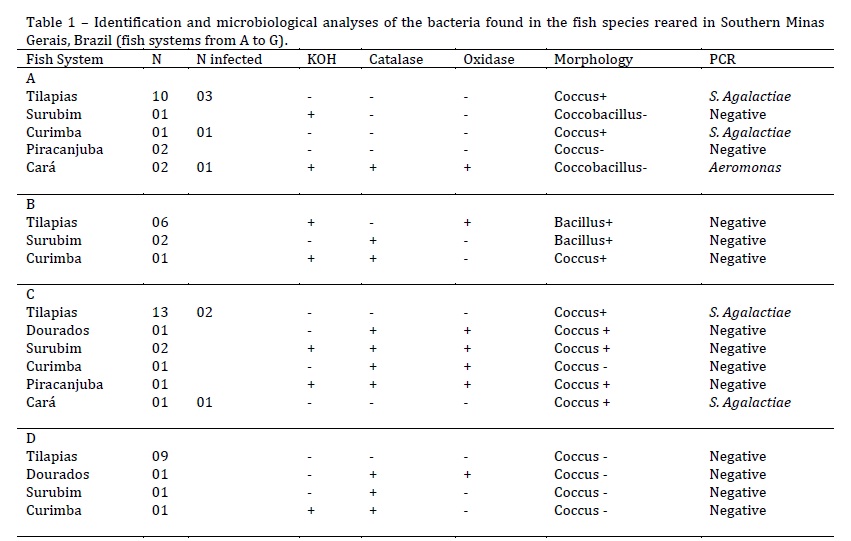Identification of pathogens in fish polyculture systems in southern Minas Gerais, Brazil
DOI:
https://doi.org/10.21708/avb.2019.13.1.7837Resumo
Fish diseases represent a significant limiting factor in aquaculture systems. Among the many pathogens, bacteria are probably the most significant group of etiological agents. Thus, the objective of this work was to isolate and to report the incidence of streptococcosis and other possible pathogens in fish polyculture systems in the region of Lavras, state of Minas Gerais, Brazil. Fish samples were randomly collected from seven fish polyculture systems in the region, including the following municipalities: Lavras, Itutinga, Itumirim, Nepomuceno, Carrancas, São Sebastião da Vitória, and Ingaí. The specimens analyzed were: Tilapia (Oreochromis niloticus), Dourado (Salminus brasiliensis), Cará (Geophagus brasiliensis), Curimba (Prochilodus lineatus), Surubim (Pseudoplatystoma corruscans), and Piracanjuba (Brycon orbignyanus). Samples of kidney, brain, liver, spleen, and intestinal tract, and skin scraping was collected and sown in a culture medium. After the incubation period, the microorganisms were identified according to the culture, morphology, dyeing, and biochemical characteristics of the bacteria. Colonies of Streptococci, Aeromonas, and Edwardsiella were identified in Tilapia, Cara, Curimba, and Surubim fish species. The results showed the identification of the bacteria in fish polyculture systems in the region of Lavras, southern Minas Gerais. Therefore, greater sanitary control and the development of other studies to treat diseases related to these pathogens are necessary.
Downloads

Downloads
Publicado
Edição
Seção
Licença
Autores que publicam na Acta Veterinaria Brasilica concordam com os seguintes termos: a) Autores mantém os direitos autorais e concedem à revista o direito de primeira publicação, com o trabalho simultaneamente licenciado sob a Licença Creative Commons Attribution que permite o compartilhamento do trabalho com reconhecimento da autoria e publicação inicial nesta revista. b) Autores têm autorização para assumir contratos adicionais separadamente, para distribuição não-exclusiva da versão do trabalho publicada nesta revista (ex.: publicar em repositório institucional ou como capítulo de livro), com reconhecimento de autoria e publicação inicial nesta revista. c) Autores têm permissão e são estimulados a publicar e distribuir seu trabalho online (ex.: em repositórios institucionais ou na sua página pessoal) a qualquer ponto antes ou durante o processo editorial, já que isso pode gerar alterações produtivas, bem como aumentar o impacto e a citação do trabalho publicado (Veja O Efeito do Acesso Livre).


 Esta obra está licenciada com uma Licença
Esta obra está licenciada com uma Licença 